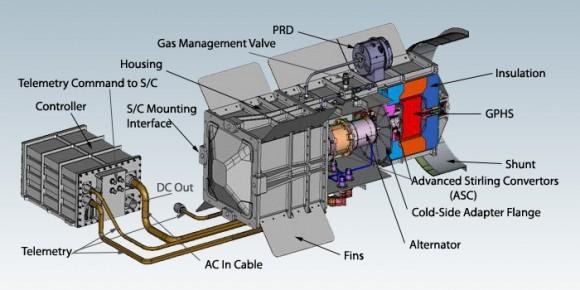NASA shelves fuel-efficient tech, effectively slashes outer planet exploration
NASA this weekend all but abandoned a money-saving technology due to a lack of money. You read that correctly. The space agency's budget woes are so suffocating that it can't even get the funding to develop ways to make missions more efficient. In this case, the efficiency would have been massive: the Advanced Stirling Radioisotope Generator (ASRG)–the program that just effectively got the ax–would have let many space missions require just one-fourth the fuel they currently need.
The ASRG is a power generator that runs on Plutonium-238. As such, it is a "radioisotope" power generator. Plutonium-238-generated power is used on missions in which solar power can't suffice. Such missions include orbital probes sent to outer planets Jupiter, Saturn, Uranus and Neptune (and Pluto, for you planet-status die-hards), as well as landing missions on dust-choked Mars and the dark side of the moon (where landers spend long periods in shadow.)

The ASRG would have replaced the customary Radioisotope Thermoelectric Generator (RTG) used on non-solar-powered missions. The newer generator, which was being developed jointly by NASA's Planetary Science Division and the US Department of Energy, draws electricity-generating heat from Plutonium-238 at four times the efficiency of the older generator. Check out the animated ASRG demo below:
This would have let NASA use one-fourth the Plutonium-238 it normally has to use for big-budget space missions and would have bode extremely well for inexpensive space exploration. It takes the Department of Energy a whole year to produce 1 to 1.5 kg of Plutonium-238. To put that in perspective, The Planetary Society pointed out that the New Horizons voyage to Pluto used about 11 kg of the isotope–about 7 to 11 years' worth of fuel production. Had the mission been equipped with a suitcase-sized ASRG unit, that production time would have been cut down to about two to four years.
That means more big-budget missions would have been possible with ASRG technology. NASA will still pursue such missions–just far less often than they could have done without the effective loss of the ASRG program.
The announcement of the end of this fiscally common-sense program came via NASA's Planetary Science Division director Jim Green, who said: "With an adequate supply of Plutonium-238, and considering the current budget-constrained environment, NASA has decided to discontinue procurement of ASRG flight hardware. We have given direction to the Department of Energy, which manages the flight procurement, to end work on the flight units. The hardware procured under this activity will be transferred to the Glenn Research Center to continue development and testing of the Stirling technology."
In other words, ASRG technology will still be kept on life support, but by removing flight hardware procurement from the program, the program as a whole is effectively no longer being taken seriously. For now, it will be a living museum piece in a laboratory. Let's hope NASA's budget constraints loosen up sometime this decade.
SOURCE: The Planetary Society
